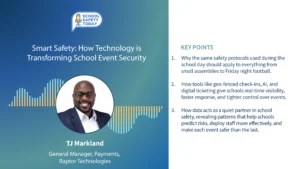4 Priorities for Crisis Management and Communications in Schools
A college campus is an exciting place filled with hundreds, thousands—or even tens of thousands—of students seeking to better themselves through education, as well as faculty and campus employees. Aside from providing the facilities, faculty, and resources necessary for a high-quality education, the school also has a solemn obligation to ensure the safety of everyone on campus as well. It is essential to have tools and processes in place to effectively respond to incidents, communicate and collaborate efficiently, and account for all individuals throughout an event.
It is a matter of when, not if, a crisis event will occur. It is essential that school administrators invest the time and effort up front to understand risks and develop contingency plans to address potential scenarios. That includes anything and everything from hurricanes, tornadoes, floods, and earthquakes, to building fires or hazardous materials spills, to active shooter situations. Schools need to do their research and invest in tools to help effectively manage and mitigate incidents.
Protecting students and faculty
Regardless of the scenario, the ability to quickly disseminate relevant information to everyone involved is essential. Campuses have to deal with an array of potential threats or events. Even something as innocuous as a power outage needs to be efficiently communicated to affected parties. If a school does not have the tools and processes in place to effectively manage crisis events, it can result in unnecessary property damage or loss and expose students and faculty to increased risk.
It is essential to educate students and faculty about potential risks and the crisis management and response plan. There should be ongoing awareness efforts throughout the student population and across the campus using websites, social media, posters on buildings, and other methods to ensure people know the system and that they can trust it. You should also conduct regular practice drills each school term so everyone knows what to expect.
Managing crisis communications
When an event or crisis occurs, quick and clear communication helps ensure the transparency necessary for everyone to understand what they need to do to stay safe, and enables decisive action to respond effectively and manage activities to address and resolve any issues. It’s important for everyone affected—or potentially affected—to have a clear understanding of the steps they should take, and it is crucial for crisis management and first responder teams to have complete visibility of the situation and effective communication.
There are four primary elements to consider when developing plans and researching tools for crisis management and response. You need to make sure you can account for every individual, that you have the ability to communicate effectively with affected parties, tools and processes to foster efficient collaboration between responders, and an ability to protect the privacy and confidentiality of personal and sensitive information.
Accounting for individuals
Do you know who is on campus, or who is currently in a given area affected by the crisis event? Keeping class rosters up to date is a good first step, but that won’t help you know who is actually in class at a given time. Your crisis management tool should enable you to request the status of individuals, groups, or the entire campus population to allow people to check-in with their location or confirm that they are safe.
Mass notifications
You need to be able to communicate efficiently during a crisis or event to share relevant information with affected individuals. People have preferences for the communication methods and platforms they use. Don’t assume that any single method is sufficient for disseminating urgent details. Depending on the nature of the crisis or event, people may not have access to an internet or cellular connection and may not be able to use some methods of communication. For urgent situations, you should consider as many channels as possible and communicate via email, SMS/text messaging, apps, social media, radio, and even signs posted at key spots across campus. Loudspeaker and fire alarm systems are also effective alert delivery systems.
Effective collaboration
Many events require a coordinated response that involves campus resources, as well as local law enforcement, fire, ambulance, and health authorities. You should have established relationships with these agencies and organizations. It is important to identify key stakeholders and understand the chain of command and communication protocols before an emergency occurs. During crisis management and response, this trusted network will be essential. Follow the same principles and guidelines for communication to ensure that you can collaborate and coordinate effectively even if the power is out or certain platforms are unavailable.
Privacy and confidentiality
Communication and collaboration in a crisis often involve sharing sensitive information, such as the location or personal information of affected faculty or students. It is important to consider privacy concerns and maintain compliance with any applicable data privacy regulations or guidelines. Your crisis communications should be deployed behind a firewall within the local network, or in a secure cloud environment to ensure privacy and confidentiality.
Be prepared
Ensuring the safety of students, staff, and the community connected to your campus is crucial, and it is going to be even more important as we move forward. Events and catastrophes will occur, and an effective emergency notification system and incident response process can literally save property and—more importantly—lives.
Make sure you have as much visibility as possible of the entire campus environment, so you have the information and context to make the best possible decisions, and ensure you have the processes and tools in place to effectively communicate with affected individuals and efficiently coordinate resources for an optimal response and minimal disruption to campus activity.
Follow us on social media for the latest updates in B2B!
Twitter – @MarketScale
Facebook – facebook.com/marketscale
LinkedIn – linkedin.com/company/marketscale








